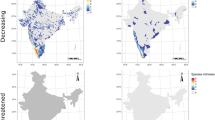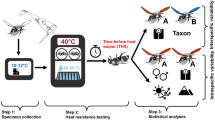Abstract
The phenology of many ecological processes including pollination service is modulated by surface air temperature, making them potentially sensitive to climatic change. The Japanese hornfaced bee, Osmia cornifrons (Hymenoptera: Megachilidae), was introduced into the USA in the 1970s and has been used as a key pollinator of spring blooming fruit crops such as apple and blueberry. This study examined the effects of future climate change on three key phenological events of O. cornifrons: date for adult emergence (female and male) in spring, date for completion of egg and larval development, and duration for the development in the Eastern USA. We used daily temperature data obtained from 21 models in Coupled Model Intercomparison Project Phase 5 for 2006–2100 under the two future climate scenarios of Representative Concentration Pathways (RCPs 4.5 and 8.5). We estimated the Julian dates (JDs) of spring emergence and development of O. cornifrons using the phenological parameters derived from temperature-dependent biophysical models. The JDs for the bee emergence and development are projected to be significantly advanced in the Eastern USA under the RCP 4.5 and 8.5 scenarios. The number of days for bee development is projected to be longer in the southern region (+ 0.57 days/decade) and shorter in the central (− 0.27 days/decade) and northern (− 0.65 days/decade) regions of the Eastern USA (all the p values < 0.01). The significantly longer duration of bee development under future climate change could pose a risk to the bee due to the longer period of being exposed to its pests. Implications for management of O. cornifrons population were discussed in this article.



Similar content being viewed by others
References
Ahn JJ, Park Y-L, Jung C (2014) Modeling spring emergence of Osmia cornifrons Radoszkowski (Hymenoptera: Megachilidae) females in Korea. J Asia Pac Entomol 17:901–905
Ahn JJ, Son Y, He Y, Lee E, Park Y-L (2016) Effects of temperature on development and voltinism of Chaetodactylus krombeini (Acari: Chaetodactylidae): implications for climate change impacts. PLoS One 11:e0161319
Angilletta MJ (2009) Thermal adaptation: a theoretical and empirical synthesis. Oxford University Press
Baek S, Son Y, Park Y-L (2014) Temperature-dependent development and survival of Podisus maculiventris (Hemiptera: Pentatomidae): implications for mass rearing and biological control. J Pest Sci 87:331–340
Bartomeus I, Ascher JS, Wagner D, Danforth BN, Colla S, Kornbluth S, Winfree R (2011) Climate-associated phenological advances in bee pollinators and bee-pollinated plants. Proc Natl Acad Sci 108:20645–20649
Bartomeus I, Park MG, Gibbs J, Danforth BN, Lakso AN, Winfree R (2013) Biodiversity ensures plant–pollinator phenological synchrony against climate change. Ecol Lett 16:1331–1338
Batra SWT (1997) Management of hornfaced bees for orchard pollination. http://www.pollinatorparadise.com/solitary_bees/hornface.htm. Accessed 9 July 2017
Batra SWT (1998) Hornfaced bees for apple pollination. Am Bee J 138:364–365
Campbell A, Frazer B, Gilbert N, Gutierrez A, Mackauer M (1974) Temperature requirements of some aphids and their parasites. J Appl Ecol 11:431–438
Discover Life http://www.discoverlife.org. Accessed 8 August 2017
Dixon AF, Honěk A, Keil P, Kotela MAA, Šizling AL, Jarošík V (2009) Relationship between the minimum and maximum temperature thresholds for development in insects. Funct Ecol 23:257–264
Giannini TC, Costa WF, Cordeiro GD, Imperatriz-Fonseca VL, Saraiva AM, Biesmeijer J et al (2017) Projected climate change threatens pollinators and crop production in Brazil. PLoSONE 12(8):e0182274
Greer L (1999) Alternative pollinators: native bees. ATTRA Hortic Technical Note
Hegland SJ, Nielsen A, Lázaro A, Bjerknes AL, Totland Ø (2009) How does climate warming affect plant-pollinator interactions? Ecol Lett 12:184–195
IPCC (2013) Summary for policymakers. In: climate change 2013: the physical science basis. Contribution of Working Group I to the Fifth Assessment Report of the Intergovernmental Panel on Climate Change Cambridge University Press, Cambridge, United Kingdom and New York, NY, USA
Lee KV et al (2015) A national survey of managed honey bee 2013–2014 annual colony losses in the USA. Apidologie 46:292–305
Lee KY, Yoon HJ, Lee KS, Jin BR (2016) Development and mating behavior of Osmia cornifrons (Hymenoptera: Megachilidae) in the constant temperature. J Asia Pac Entomol 19(2):281–287
Maeta Y, Nakanishi K, Fujii K, Kitamura K (2006) Exploitation of systems to use a univoltine Japanese mason bee, Osmia cornifrons (Radoszkowski), throughout the year for pollination of greenhouse crops (Hymenoptera: Megachilidae). Chugoku Kontyu 20:1–17
McKinney M, Ahn JJ, Park Y-L (2017) Thermal biology of Osmia cornifrons (Hymenoptera: Megachilidae) eggs and larvae. J Apic Res 56:421–429
McKinney MI, Park Y-L (2012) Nesting activity and behavior of Osmia cornifrons (Hymenoptera: Megachilidae) elucidated using videography Psyche. J Entomol 2012
Morse RA, Calderone NW (2000) The value of honey bees as pollinators of US crops in 2000. Bee Culture 128:1–15
Moss RH et al (2010) The next generation of scenarios for climate change research and assessment. Nature 463:747
Park YL, Kondo V, White J, West T, McConnell B, McCutcheon T (2009) Nest-to-nest dispersal of Chaetodactylus krombeini (Acari, Chaetodactylidae) associated with Osmia cornifrons (Hym., Megachilidae). J Appl Entomol 133:174–180
Parmesan C (2006) Ecological and evolutionary responses to recent climate change. Annu Rev Ecol Evol Syst 37:637–669
Parmesan C, Yohe G (2003) A globally coherent fingerprint of climate change impacts across natural systems. Nature 421:37–42
Petchey OL, McPhearson PT, Casey TM, Morin PJ (1999) Environmental warming alters food-web structure and ecosystem function. Nature 402:69
Schweiger O, Settele J, Kudrna O, Klotz S, Kühn I (2008) Climate change can cause spatial mismatch of trophically interacting species. Ecology 89:3472–3479
Seitz N et al (2015) A national survey of managed honey bee 2014–2015 annual colony losses in the USA. J Apic Res 54:292–304
Sgolastra F, Kemp WP, Maini S, Bosch J (2012) Duration of prepupal summer dormancy regulates synchronization of adult diapause with winter temperatures in bees of the genus Osmia. J Insect Physiol 58:924–933
Sharpe PJ, DeMichele DW (1977) Reaction kinetics of poikilotherm development. J Theor Biol 64:649–670
Shi P, Chen Z, Yang Q, Harris MK, Xiao M (2012) Influence of air temperature on the first flowering date of Prunus yedoensis Matsum. Ecol Evol 4:292–299
Son Y, Nadel H, Baek S, Johnson MW, Morgan DJ (2012) Estimation of developmental parameters for adult emergence of Gonatocerus morgani, a novel egg parasitoid of the glassy-winged sharpshooter, and development of a degree-day model. Biol Control 60:233–240
Stokstad E (2007) The case of the empty hives. Science 316:970–972
Strange JP, Delaney DA, Tarpy DR, James RR (2017) Novel microsatellite loci reveal high genetic diversity yet low population structure for alfalfa leafcutting bees in North America. Conserv Genet 18:679–687
Taylor KE, Stouffer RJ, Meehl GA (2012) An overview of CMIP5 and the experiment design. Bull Am Meteorol Soc 93:485–498
Thrasher B, Maurer EP, McKellar C, Duffy P (2012) Bias correcting climate model simulated daily temperature extremes with quantile mapping. Hydrol Earth Syst Sci 16:3309–3314
Wagner TL, Wu H-I, Sharpe PJ, Schoolfield RM, Coulson RN (1984) Modeling insect development rates: a literature review and application of a biophysical model. Ann Entomol Soc Am 77:208–220
Walther G-R et al (2002) Ecological responses to recent climate change. Nature 416:389–395
Wang X, Levy K, Son Y, Johnson MW, Daane KM (2012) Comparison of the thermal performance between a population of the olive fruit fly and its co-adapted parasitoids. Biol Control 60:247–254
White J, Son Y, Park Y-L (2009) Temperature-dependent emergence of Osmia cornifrons (Hymenoptera: Megachilidae) adults. J Econ Entomol 102:2026–2032
Acknowledgements
We acknowledge the World Climate Research Programme’s Working Group on Coupled Modelling, which is responsible for the CMIP, and we thank the climate modeling groups for producing and making available their model output. Climate scenarios used were from the NEX-GDDP dataset, prepared by the Climate Analytics Group and NASA Ames Research Center using the NASA Earth Exchange, and distributed by the NASA Center for Climate Simulation (NCCS). We thank the reviewers for their constructive comments and helpful suggestions.
Funding
The study was supported by the USDA National Institute of Food & Agriculture (NIFA) Grant (NIFA Award, 2014-67004-21631).
Author information
Authors and Affiliations
Corresponding author
Electronic supplementary material
ESM 1
(DOCX 5385 kb)
Rights and permissions
About this article
Cite this article
Lee, E., He, Y. & Park, YL. Effects of climate change on the phenology of Osmia cornifrons: implications for population management. Climatic Change 150, 305–317 (2018). https://doi.org/10.1007/s10584-018-2286-z
Received:
Accepted:
Published:
Issue Date:
DOI: https://doi.org/10.1007/s10584-018-2286-z




